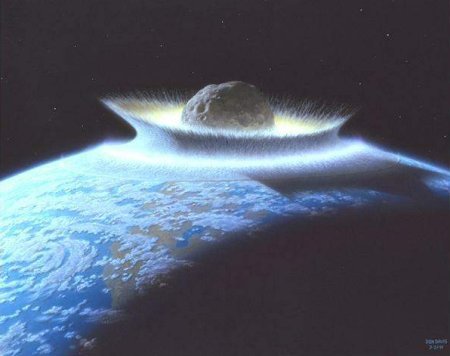a possible impact factor
In my last post related to the climate change and the G8 summit the possible uses of nuclear energy were mentioned. Among others it was remarked that nuclear material in particular uranium should not be used up in dangerous commercial nuclear power plants (where I havent even mentioned the use of these for weapon production) but e.g. rather be kept for space travel (here a rather futuristic proposal?). Here yet another suggestion:
It is a common knowledge that an outer enemy may enforce social cohesion within a social group. If this social group would be the humans on earth then there is a rather realistic outer enemy, which provides at the same time another useful use for nuclear energy, namely:
According to wikipedia the late Eugene Shoemaker of the U.S. Geological Survey came up with an estimate of the rate of Earth impacts, and suggested that an event about the size of the nuclear weapon that destroyed Hiroshima occurs about once a year. Such events would seem to be spectacularly obvious, but they generally go unnoticed for a number of reasons: the majority of the Earth’s surface is covered by water; a good portion of the land surface is uninhabited; and the explosions generally occur at relatively high altitude, resulting in a huge flash and thunderclap but no real damage, however clearly bigger meteroids may come up. According to Nick Bostrom section 4.10:
In order to cause the extinction of human life, the impacting body would probably have to be greater than 1 km in diameter (and probably 3 – 10 km)….It is estimated that a 1 km or greater body collides with Earth about once every 0.5 million years.
So in order to get a feeling for the probabilities:, the probability that this is going to happen in a year is about 28 times more then a lottery win in a lottery 6from49
So it is not that unlikely as many people think! May be it is useful to raise awareness for this danger.
For that reason e.g. the NASA published a study, which deals with this threat called
SHIELD—A Comprehensive Earth Protection System. I cite from this article:
For large hazards or short lead times, nuclear detonations are the only possible mitigation option in the near future. In terms of sheer efficiency, a nuclear detonation will provide the most ∆V for the least amount of weight of any system proposed here, given reasonably short mission times. No other device currently proposed can release the kind of energy per mass that a nuclear device can.
and
The non-nuclear technologies discussed provide an array of options for smaller bodies. Propulsive technologies such as chemical, electric, solar sails, directed energy, and mass drivers would only be effective against smaller bodies. For larger bodies the amount of fuel needed would become too large to launch into orbit.
By far the biggest disadvantage to nuclear detonations is the political and social ramifications of developing such a large, accurately targetable, highly reliable nuclear weapon. This might infringe on several treaties, and a launch
failure could cause extreme amounts of destruction. However, because of the current state of technology, not a lot of modifications would be needed to upgrade current weapons from their military role to one of hazard mitigation.
->funny Earth Impact Effects Program
for europe see also ->europaeisches feuerkugelnetz (english?)

January 7th, 2012 at 10:02 pm
Thank you in behalf of sharing this acquaintanceship!
February 15th, 2013 at 10:20 pm
link to DLR is interesting. They write:
and
and
So there is someone having an eye on these objects!
May 22nd, 2013 at 8:45 pm
Victor wrote:”So there is someone having an eye on these objects!”
Yes and for a centralized european coordination:
Watching for hazards: ESA opens asteroids centre
where
February 18th, 2016 at 6:32 pm
So do you think aliens are no threat?
Have you seen this report in the New York Times about this telescope scanning for extraterrestial life (via boing boing)?